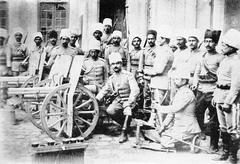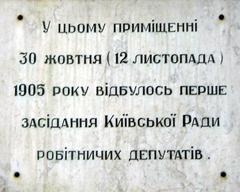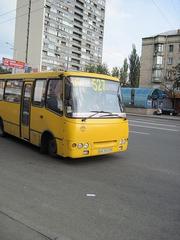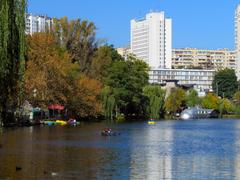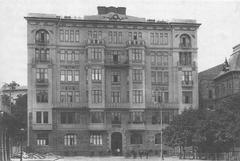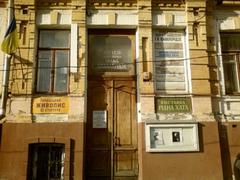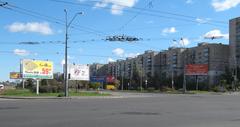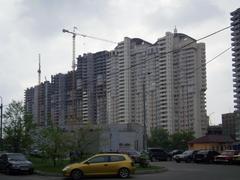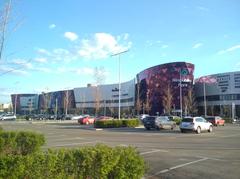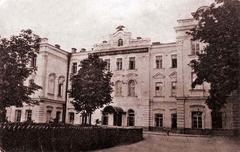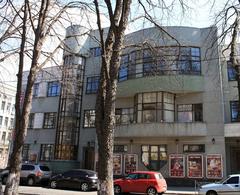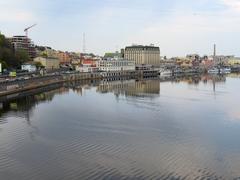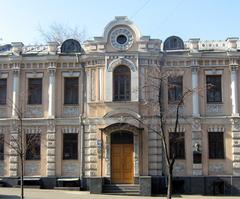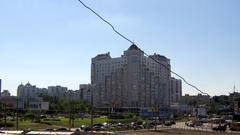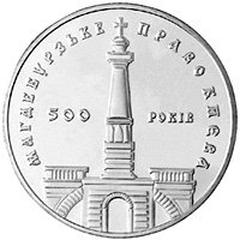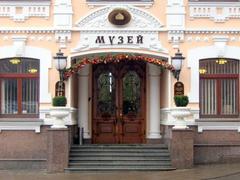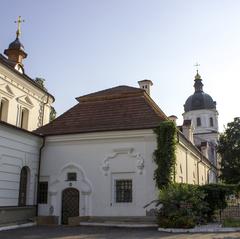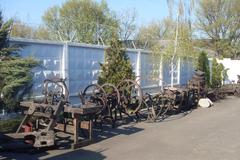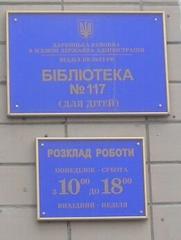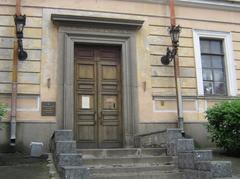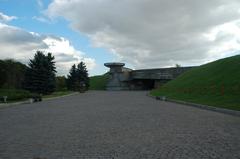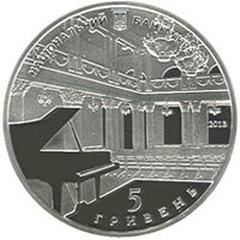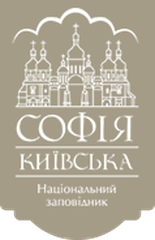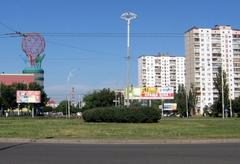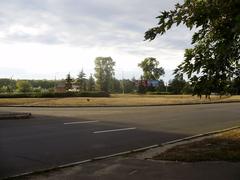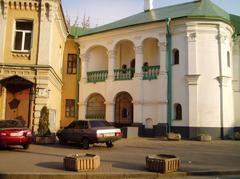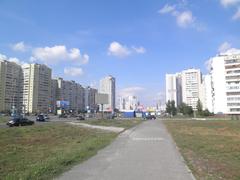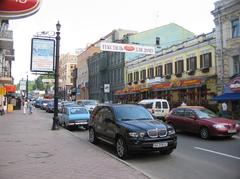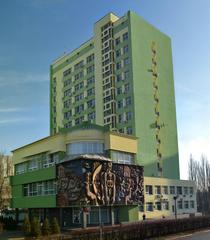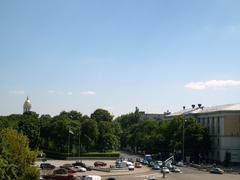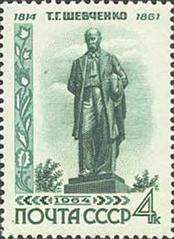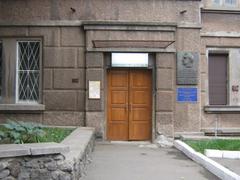
Poliarna Street Kyiv: Visiting Hours, Tickets, and Historical Sites Guide
Date: 03/07/2025
Introduction
Poliarna Street, located in Kyiv’s Obolon district, is a fascinating example of the city’s Soviet-era expansion and modern urban life. What was once a marshland has transformed into a vibrant residential area, showcasing both the architectural priorities and evolving social fabric of late 20th-century Kyiv. Renowned for its characteristic panelki apartment blocks, bustling local markets, and community spaces, Poliarna Street offers a unique perspective for those interested in experiencing authentic city life beyond Kyiv’s historic center.
Well-connected by public transport—including bus, trolleybus, and metro (with Obolon and Minska stations nearby)—the area boasts practical amenities, green parks, and seasonal events that embody the neighborhood’s spirit. This comprehensive guide covers Poliarna Street’s history, urban relevance, visitor information, and nearby attractions, equipping travelers to make the most of their visit. For further background on Kyiv’s development, see the Kyiv City Development Strategy and insights from CEDOS research.
Table of Contents
- Historical Development of Poliarna Street
- Urban Significance and Infrastructure
- Architectural and Social Landscape
- Visitor Information: Access, Hours, and Amenities
- Community and Cultural Identity
- Urban Challenges and Development Strategies
- Visitor Experience and Tips
- Visuals and Media
- Integration with Kyiv’s Urban Fabric
- Frequently Asked Questions (FAQ)
Discover Poliarna Street Kyiv: A Comprehensive Guide for Visitors
Historical Development
Poliarna Street emerged as part of Kyiv’s post-war growth, reflecting Soviet urban planning principles. Its name, meaning “Polar,” is in line with naming conventions for northern Kyiv neighborhoods. The Obolon district, formerly a floodplain along the Dnieper River, was urbanized in the 1970s and 1980s to accommodate Kyiv’s expanding population (Kyiv City Development Strategy).
The era’s hallmark was the construction of prefabricated apartment buildings known as panelki, which shape Poliarna Street’s landscape. The area was designed as a self-sufficient microdistrict, offering housing, schools, shops, and green spaces within walking distance (CEDOS, 2023).
Urban Significance and Infrastructure
Poliarna Street acts as a key connector in northern Kyiv, linking residential zones with major transport arteries like Obolonskyi Avenue and the Kyiv Ring Road (Kyiv City Guide). Its strong public transport links—several bus and trolleybus lines connect to Obolon and Minska metro stations—make it easily accessible (Rubryka, 2023). Recent pedestrian-friendly upgrades, including new crosswalks and traffic-calming measures, have enhanced safety and accessibility (Rubryka, 2021).
Architectural and Social Landscape
Poliarna Street’s architecture is a prime example of late Soviet functionalism, dominated by multi-story panelki interspersed with schools, kindergartens, and local shops. While these buildings are utilitarian, they exemplify the era’s focus on communal amenities and green courtyards (Kyiv After Chernobyl).
Renewal efforts are gradually modernizing the area: playgrounds are being refurbished, new trees planted, and public spaces upgraded, reflecting a broader city push to revitalize residential districts and foster community pride.
Visitor Information: Access, Hours, and Amenities
- Visiting Hours: As a public street, Poliarna is accessible 24/7. Commercial venues operate mainly from 8:00 a.m. to 8:00 p.m. Markets and bakeries may open from 7:00 a.m.
- Tickets & Fees: There are no entrance fees; the street is open for all.
- Accessibility: Ongoing improvements ensure wheelchair-friendly sidewalks and crossings. Public transport is generally accessible.
- Transport: Reachable via bus and trolleybus lines from Obolon and Minska metro stations. Check Kyiv’s public transport maps or apps for routes.
- Tours: Urban exploration tours focusing on Soviet-era districts may include Poliarna Street.
- Events: Look out for seasonal fairs and community events in local parks—these are announced on community boards and social media.
Community and Cultural Identity
Though not a tourist hub, Poliarna Street offers a window into real Kyiv life. Its schools, markets, and parks are at the heart of the community, while local events such as fairs and children’s festivals foster a strong sense of belonging (Kyiv After Chernobyl). The area’s population is diverse, and amenities reflect this, ranging from traditional bakeries to modern fitness centers.
Urban Challenges and Development Strategies
Poliarna Street faces typical urban challenges: traffic congestion, limited parking, and aging infrastructure (Rubryka, 2023). Kyiv’s city strategy emphasizes sustainable growth, improved infrastructure, and environmental protection (Kyiv City Development Strategy). Ongoing projects on Poliarna Street focus on road safety, utility upgrades, and public space enhancement (CEDOS, 2023).
Visitor Experience and Tips
- Experience: Walk the street to observe local life, visit cozy cafes, shop at markets, and relax in nearby parks. The Dnieper River’s recreational areas are nearby.
- Safety: The area is generally safe, but stay aware of surroundings, especially at night when most amenities close by 10:00 p.m. Nightlife is limited.
- Practical Tips: Purchase tickets for public transport in advance, use translation apps as English is less common away from tourist areas, and carry some cash for small purchases.
Visuals and Media
Find photos and interactive maps of Poliarna Street via Kyiv city guides and public transport websites. Popular photo spots include green courtyards and parks with panelki backdrops. For more images, see the Wikimedia Commons category for Poliarna Street, Kyiv.
Integration with Kyiv’s Urban Fabric
Poliarna Street’s evolution from a Soviet-era artery to a modern neighborhood encapsulates Kyiv’s broader journey toward renewal and resilience. As Kyiv implements its strategic plans, areas like Poliarna Street are integral to the city’s vision for vibrant, inclusive urban living (Kyiv After Chernobyl; CEDOS, 2023).
Frequently Asked Questions (FAQ)
Q: What are the visiting hours for Poliarna Street?
A: The street is accessible 24/7; shops and facilities usually open 8:00 a.m.–8:00 p.m.
Q: Is there an entrance fee?
A: No, Poliarna Street is a public area and free to access.
Q: How do I get there by public transport?
A: Multiple bus and trolleybus routes connect to Obolon and Minska metro stations.
Q: Is the area wheelchair accessible?
A: Yes, with ongoing upgrades to improve accessibility.
Q: Are guided tours available?
A: Some local guides offer tours focusing on Soviet-era neighborhoods.
Q: What else is there to do nearby?
A: Visit local markets, parks, and the Obolon Embankment for river views.
Nearby Historical Sites & Attractions
Kyiv Pechersk Lavra
One of Ukraine’s most significant landmarks, the Kyiv Pechersk Lavra is a UNESCO World Heritage Site known for its ancient caves, beautiful churches, and religious treasures.
- Hours: 9:00 a.m.–6:00 p.m.
- Tickets: Admission ranges from 50–100 UAH; buy onsite or online.
- Transport: Easily accessible via Arsenalna metro station.
- Accessibility: Most areas are accessible, but the caves may be challenging for some visitors.
(UNESCO World Heritage Centre - Kyiv Pechersk Lavra)
National Museum of the History of Ukraine
A premier institution housing artifacts from ancient Kyivan Rus to modern times.
- Hours: Tues–Sun, 10:00 a.m.–6:00 p.m.
- Tickets: About 150 UAH; discounts available.
- Transport: Near Heroiv Dnipra and Minska metro stations.
- Accessibility: Elevators and accessible restrooms available.
(OpenAlfa)
(Visit Ukraine Today)
Safety and Practical Tips
- Curfew: Kyiv enforces a midnight–5:00 a.m. curfew. No movement is permitted during this time.
- Checkpoints: Carry ID for security checks.
- Air Raid Alerts: Download the “Air Alert Ukraine” app for notifications; familiarize yourself with shelter locations.
- Transport: Use official taxi apps (Uklon, Bolt) and avoid unregistered taxis.
- Language: Ukrainian is official, but Russian is common; English is spoken in tourist areas.
- Currency: Ukrainian Hryvnia (UAH); credit cards are widely accepted.
- Health: Use bottled water and well-reviewed eateries.
- Connectivity: Free Wi-Fi is common; local SIM cards are affordable.
Visuals
Related Articles
External Resources
- Kyiv City Development Strategy
- CEDOS Research
- Rubryka Analysis on Kyiv Traffic
- Kyiv City Guide
- Kyiv After Chernobyl: Urban Resilience
- Visit Ukraine Today
- Wikimedia Commons, Poliarna Street, Kyiv Images
Summary and Call to Action
Poliarna Street is a living testament to Kyiv’s resilience and transformation, offering visitors a genuine experience of local life. The street’s role as a connector, its accessible amenities, and its proximity to markets, parks, and historical sites make it a rewarding destination for those seeking more than just traditional sightseeing.
To stay updated on events, safety, and local tips, download the Audiala app and follow Kyiv’s official tourism platforms. Explore further resources like Kyiv After Chernobyl: Urban Resilience and Rubryka’s Kyiv traffic analysis for deeper insight into the city’s ongoing evolution. Plan your visit and discover the authentic heart of Kyiv on Poliarna Street.


